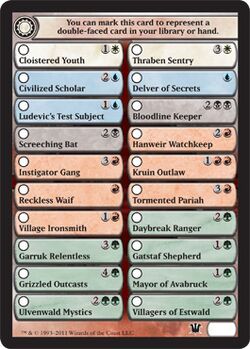Double-faced card: Difference between revisions
>LegacymtgsalvationUser1033 No edit summary |
>LegacymtgsalvationUser1033 mNo edit summary |
||
| Line 2: | Line 2: | ||
'''Double-faced Cards''' were first introduced in '''''Magic''''' with the set ''[[Innistrad]]'' and represent a radical change for the [[Card frame]]. Until their release, no legal card could have a different print on the back than the regular Magic card back. However, double-faced cards have a regular card frame on each side. | '''Double-faced Cards''' were first introduced in '''''Magic''''' with the set ''[[Innistrad]]'' and represent a radical change for the [[Card frame]]. Until their release, no legal card could have a different print on the back than the regular Magic card back. However, double-faced cards have a regular card frame on each side. | ||
{{CR|Innistrad|*'''711.''' | {{CR|Innistrad|*'''711.''' Double-Faced Cards | ||
*'''711.1.''' Each double-faced card has a Magic card face on each side rather than a Magic card face on one side and a Magic card back on the other. Each face may have abilities that allow the permanent to "transform," or turn over to its other face. Tokens and cards with a Magic card back can't transform. (See rule 701.25, "Transform.") | *'''711.1.''' Each double-faced card has a Magic card face on each side rather than a Magic card face on one side and a Magic card back on the other. Each face may have abilities that allow the permanent to "transform," or turn over to its other face. Tokens and cards with a Magic card back can't transform. (See rule 701.25, "Transform.") | ||
**'''711.1a''' A double-faced card's front face is indicated by the sun symbol in its upper left corner. | **'''711.1a''' A double-faced card's front face is indicated by the sun symbol in its upper left corner. | ||
Revision as of 16:36, 29 September 2011

Double-faced Cards were first introduced in Magic with the set Innistrad and represent a radical change for the Card frame. Until their release, no legal card could have a different print on the back than the regular Magic card back. However, double-faced cards have a regular card frame on each side.
Lua error in Module:CR at line 549: Unknown error, multiple lookups .
Playing with double-sided cards
Double-faced cards have an icon next to the name representing a sun or a moon. The front of the card is called the day side and has a regular card frame and has the sun symbol. The night side has the moon symbol and a slightly altered frame similar to Planeshifted cards with a darker textbox and white text for the card type, name, and Power/Toughness.
Double-sided cards enter the battlefield with their day side. To switch between the two card faces, the keyword action transform is used. During transformation, all counters, Auras and Equipment stay on the card, and the card neither enters nor leaves the battlefield.
To be allowed to play with double-sided cards, the player must have opaque sleeves for all his cards through which no detail of the cards are visible. If the player has no sleeves or only non-opaque sleeves, the player may use a checklist card which are available with the sets. Checklist cards have the regular magic card back and list all double-faced cards from a set. The player must mark which double-faced card the checklist card is meant to represent on the checklist card, in a manner not visible from the the back of the card. The checklist card is shuffled into the deck while the actual double-faced card is kept outside the game.
Rulings
- Double-faced cards can not be turned face down with cards such as Ixidron. When a double-faced card is instructed to be turned face-down. Nothing happens. Similarly, if a non-double-faced card is instructed to transform, nothing happens.
- When a double-sided card is copied, e.g. with a card like Clone, only the characteristics of the face that is currently visible upon copying are copied. Such copies can not transform either.
- If a card is not in play, the only information relevant and viewable for other cards is the day side of the card.
- The color identity of the card includes either face.